I am and always have been a fan of history. Since my earliest days in elementary school, when going to the library, you could find me browsing the biography section when my classmates were more interested in the Peanuts gang and their leader Charlie Brown. I would read the stories of great historical leaders like George Washington, Abraham Lincoln, and one that has stayed with me due to my Indiana home, “Mad Anthony” Wayne. I was fascinated by their exploits and wanted to learn more about how they weathered the many storms and difficulties in order to stay the course and build our great nation. This interest grew over my life and I have read hundreds of books that others would simply leave on the shelf. My interest eventually became more focused on the French & Indian War, Revolutionary War and the War of 1812. So you can imagine my excitement when in 2016, GMT Games Released Liberty or Death: The American Insurrection. This game would give me an opportunity to try my hand at history and see if I could do as good a job in securing independence as the Patriots did.
What is Liberty or Death About?
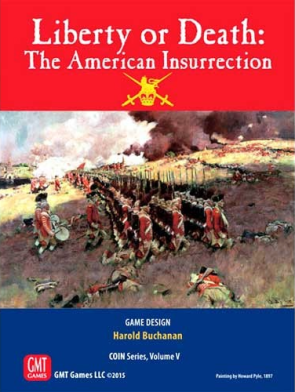 The fifth volume in GMT’s COIN Series, Liberty or Death: The American Insurrection is the series’ first foray into non-modern warfare and takes us to the 18th Century and the days of the Brown Bess musket, the 18 pounder siege cannon and nice and tidy formations better suited for a gentleman’s war. The focus of the game is the struggle of the American Patriots against their mother British government as they have made their intentions clear to become independent with the Declaration of Independence. The game is a multi-faction treatment of the American Revolution, which includes the Patriots and their allies the French against the British and their reluctant allies the Indians. Liberty or Death is a 1 to 4 player game focused on all aspects of the struggle including financing operations with Rabble Rousing, infiltrating British held cities to Skirmish, blockading major cities with the mighty French fleet, Raiding the frontiers with the Indian nations, the spread of propaganda to build support for the revolution, fort building and small scale battles. So, with this short description you can see that this game is not a “traditional” wargame but does contain some armed conflict. So a game about the American Revolution that isn’t focused on battle you say? How can that be? Well, I will tell you that this game is probably a perfect representation of the multifaceted struggle that wasn’t necessarily decided on the field of combat, but by the little actions of many behind the scenes characters. Yes battle will decide the control of major areas of the board and decide the fate of troops as they must be concerned about being in supply through a network of forts but the game is so much more than just rolling some dice and consulting a CRT!
The fifth volume in GMT’s COIN Series, Liberty or Death: The American Insurrection is the series’ first foray into non-modern warfare and takes us to the 18th Century and the days of the Brown Bess musket, the 18 pounder siege cannon and nice and tidy formations better suited for a gentleman’s war. The focus of the game is the struggle of the American Patriots against their mother British government as they have made their intentions clear to become independent with the Declaration of Independence. The game is a multi-faction treatment of the American Revolution, which includes the Patriots and their allies the French against the British and their reluctant allies the Indians. Liberty or Death is a 1 to 4 player game focused on all aspects of the struggle including financing operations with Rabble Rousing, infiltrating British held cities to Skirmish, blockading major cities with the mighty French fleet, Raiding the frontiers with the Indian nations, the spread of propaganda to build support for the revolution, fort building and small scale battles. So, with this short description you can see that this game is not a “traditional” wargame but does contain some armed conflict. So a game about the American Revolution that isn’t focused on battle you say? How can that be? Well, I will tell you that this game is probably a perfect representation of the multifaceted struggle that wasn’t necessarily decided on the field of combat, but by the little actions of many behind the scenes characters. Yes battle will decide the control of major areas of the board and decide the fate of troops as they must be concerned about being in supply through a network of forts but the game is so much more than just rolling some dice and consulting a CRT!
I am sure that you have noticed that this game is the fifth volume in the COIN Series and you might be interested in what the differences are between Liberty or Death and the other four volumes. First off, other than the game being the series first foray into anything other than recent conflicts, the game is designed as a 1-4 player game but in this version of the COIN Series, the factions truly need each other. What I mean by this is that there are two clear sides. The first side includes the liberty seeking Patriots led by George Washington and their powerful French allies against the British, hoping to hold onto the Colonies for as long as they can in partnership with their truly reluctant allies the Indians, who literally are forced to choose between the lesser or two evils and take the side of the British because the colonists continue to gobble up their land as they expand west ruining their hunting grounds, sacred sites and threatening their way of life. While each side can still win a victory for themselves by accomplishing their very interesting victory conditions, each really needs the other for any realistic shot at victory and simply cannot go it alone.
The Patriots need the French because they are desperately underfunded and the French can, using their French Agent Mobilization (to place 2 Militia or 1 Continental in Quebec, New York, New Hampshire or Massachusetts) and Roderigue Hortalez Et Cie (to increase Patriot resources to provide means to Rally, March and Battle) Commands to aid the rebellion while biding their time until they can play the infamous Treaty of Alliance and enter the fray. While on the flipside, the Indians need the resources of the British in a similar way. The Indians must open up diplomatic relationships with the British to be able to Trade (British choose a number of resources to give to the Indians) and also to perform clandestine activities such as Raiding (move an adjacent War Party into a Province and then place a Raid marker and shift Opposition one level to Neutral), Scouting (move a War Party accompanied by Regulars and Tories into a Province and then Skirmishing) and Plundering (Transfer from Patriots to Indians the Province’s population value in resources) to take away precious resources and men from the Patriots making it easier for their Lobsterback allies to clear the invaders from their territory and minimize the threat to the nation from adjoining Provinces. This co-dependence is very important, very thematic and also very well done.
One issue that I want to cover here is how the COIN Series has turned the wargaming world upside down. You might ask yourself, what is he talking about? Well, as you may or may not know, the COIN Series of games has created an entirely new and unique wargaming experience that has attracted and converted many a Eurogamer over to the side of wargamers, including myself! My reference to The World Turned Upside Down is a reference to the song that the British band supposedly played as Lord Charles Cornwallis’s proxy Brigadier General Charles O’Hara surrendered at Yorktown to end the Revolutionary War and open a new world for those that wanted freedom and independence. This new type of hybrid Euro game, where something other than square cardboard counters are used to represent armies, navies and forts, has created a gray area that provides an entry point for many into the world of hex and counter gaming! The familiar mechanics of Euro games, including a take on worker placement for the Sequence of Play track, are evident in the COIN Series and in the design for Liberty or Death, and this has attracted many new followers. This is a good thing in my opinion as it has made a fairly complex and exclusive club more open to membership by all.
It also is nearly impossible to examine Liberty or Death without discussing the obvious 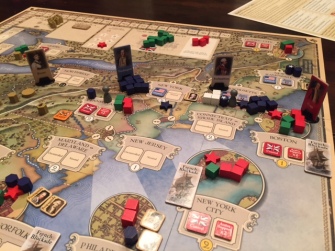 question about how a system that was originally designed to model modern asymmetrical warfare can function well in an 18th century game set in North America? My answer to this question is very well. First, lets look at the Battle Procedure. 18th century warfare can be characterized as slow, plodding and methodical. There were no helicopters, air drops or truly long range artillery that would change the battlefield. It was simply a group of soldiers lined up in nice tidy formations to slug it out on an open field within yards of each other. Therefore, armies couldn’t march quickly and engage quickly, it took time, planning and logistics. Well, in Liberty or Death, you cannot March and Battle in the same turn (unless you pull an event that allows this) so battles must be thought over. Also, the battles are very attritional and very rarely does one force totally wipe out another force, but armies are whittled down by larger armies until they are no longer on the board or have moved away for self preservation.
question about how a system that was originally designed to model modern asymmetrical warfare can function well in an 18th century game set in North America? My answer to this question is very well. First, lets look at the Battle Procedure. 18th century warfare can be characterized as slow, plodding and methodical. There were no helicopters, air drops or truly long range artillery that would change the battlefield. It was simply a group of soldiers lined up in nice tidy formations to slug it out on an open field within yards of each other. Therefore, armies couldn’t march quickly and engage quickly, it took time, planning and logistics. Well, in Liberty or Death, you cannot March and Battle in the same turn (unless you pull an event that allows this) so battles must be thought over. Also, the battles are very attritional and very rarely does one force totally wipe out another force, but armies are whittled down by larger armies until they are no longer on the board or have moved away for self preservation.
I also really enjoy the feel of the Winter Quarters phase, which is the new version of the Propoganda/Coup phase from earlier versions such as Fire in the Lake. The Winter Quarters phase most definitely brings an 18th century feel to the game as armies just didn’t fight when weather turned poor in North America. There might be small skirmishes or guerilla strikes but when you have to traverse hundreds or even a thousand miles to reach the enemy across snow covered muddy roads, you just don’t do it. You don’t have enough food, there is not enough lodging or cover for your troops and the bitter temperatures cause nasty ailments such as frost bite, trench foot and exposure. The Winter Quarters phase sees each player try to hunker down in their nice warm camps (Valley Forge was definitely not this for the Patriots in 1777), gain supply through scavenging, try to buy support for their cause, redeploy armies and Leaders and try desperately to prevent desertions (the Patriots lose 1 in every 5 Militia and Continentals and the British lose 1 in 5 Tories during Winter Quarters). This step rewards players who plan and who have established a good network of controlled cities, or have established forts. There is little worse in the game than having to pay resources you really don’t have because your large army is not located in a fort. This can be devastating and feels very authentic.
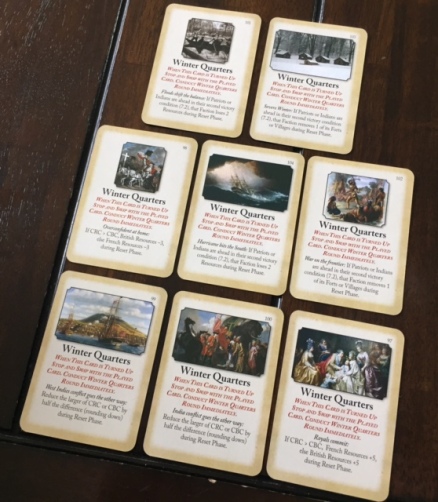
One other great part about the design is the Sequence of Play area of the main board. This is where the factions decide what actions they will be taking on their turn. You simply move the faction’s piece onto the 1st Faction space that you choose (either Command Only, Command and Special Activity or Event) followed by your opponent, or you again depending on who is eligible, placing in turn. There is some real gamesmanship with this part of the design as you will sometimes want to take an Event because it is so beneficial for your plans or do all that you can with a Command and Special Activity, but there are also times when you might want to play keep away with the Event as it is very devastating to you or not allow your opponent access to the full Command and Special Activity box. This becomes a real game of cat and mouse and can be truly frustrating for one side or the other who has great plans but simply cannot make those plans happen due to skillful negation of the minefield of the track by your opponent.
I absolutely love Liberty or Death and am very glad that this was my first COIN Series game. I was truly nervous when I bought my copy in February 2016 as I had no idea what to really expect. After my first play, I was hooked. I have now played about 20 times, with a majority of those plays being done solo, which is a very well done system in and of itself that also takes a little time to get down pat. I recommend this great game to all players who love the COIN Series or who have a passion for the Revolutionary War. This game is a very good representation of that struggle and brings its own élan to the battlefield that I truly have enjoyed.
What I Liked About Liberty or Death
There is a lot to like about this game. It is very well done and you can tell that it is also a labor of love for the designer Harold Buchanan. The attention to detail and the incorporation of 18th century elements into the gameplay, have created a glorious simulation on arguably the greatest struggle in our nation’s history.
Production Value – I will say it. The map used for Liberty or Death is a virtual piece of art! It is undoubtedly the most beautiful and well designed board I have ever seen and adds such a layer of immersion for players to be able to get into the mood and feeling of the conflict. The relief drawings of trees, mountains and hills on the board are so reminiscent of being on the frontier that I actually can hear when I play the song of birds in the forest, the sounds of rushing water from nearby streams and the other unknown noises that originate from the deep and dark forests of the frontier. I am sure that the British, who were more used to level and flat plains of grass to do battle in, were unnerved at this foreign world.
Aside from the map, the game pieces are very sturdy, including great multi-colored wooden cubes that can be lined up in formations on the map demonstrating their amassed power ready to assault, fantastically illustrated cards with great flavor text, thick and durable cardboard counters to track the administrative functions of the game, and an amazingly simple to follow play book that gives several examples of play (not intended to teach you in depth strategy or tactics) to give you a feel for the various options available to each faction.
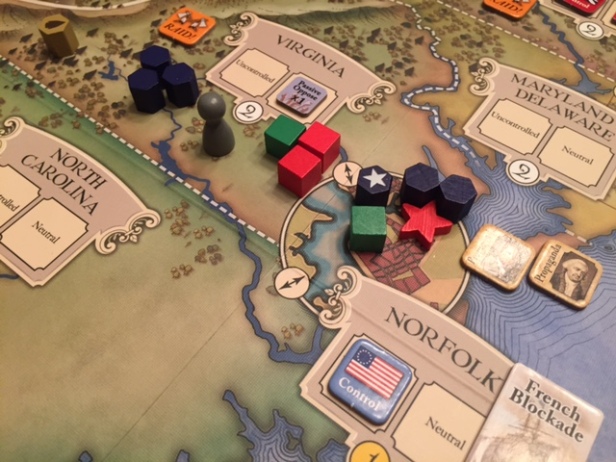
With all of that being said, each teamed faction must watch carefully their teammates victory conditions and understand where it is that they stand throughout the game, which creates some really great tension and tough decisions during play. I have seen the British refuse to give the Indians resources, citing their own troubles or difficulty, as well as the French stubbornly only giving 1 Resource to the Patriots when they could have afforded at least a few more. This tension and veiled cooperation is one of the best parts of the game and really shines only when the game is played with 4 players.
18th Century Feel to Battle – I really enjoyed that the Battle procedure is very attritional in nature and doesn’t necessarily lead to one force totally destroying another. Rather, it focuses on losses determined by a fairly simple calculation. This is determined by first calculating the number of forces present (Regulars count as one and Militia/Warbands count as 1/2) then leads to a certain number of dice being rolled (Simply divide your total by 3 and leading to one dice per 3 with a maximum of 3 dice) and then modifying the rolls by such elements as whether there is a Leader present, whether half of the attacking units are Regulars, the existence of a fort, presence of French Blockades, underground units, etc. In the overall strategy of the game, the use of concentrated forces is encouraged with this formula that involve all of the various elements in order to maximize the outcome. Small forces are not good as they are simply swept from the map by larger forces.
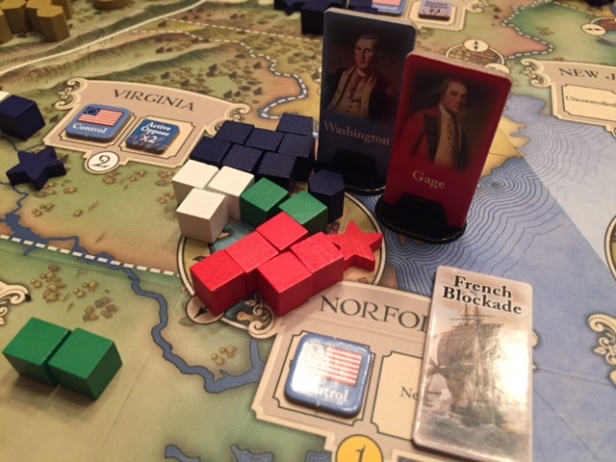
I also feel in our various plays that in general, the Patriots tend to try to form a major northern army that patrols New York, Pennsylvania and New Jersey as well as a southern army that focuses on South Carolina, North Carolina and Virginia. The Patriots also tend to fight like hell in order to get a foothold in the south (particularly in the A People Numerous and Armed long scenario) and try very hard to get and keep a fort from which to Rally and recruit new troops. The British on the other hand seem to try and stick to the major cities like Boston, New York City and Philadelphia in the north and Savannah, Norfolk and Charlestown in the South and venture out cautiously to do battle or simply threaten certain areas causing the Patriots to react, which also feels very appropriate.
Event Cards – COIN Games rely on printed event cards that are used for several purposes. The first and most important purpose is to set up the order of play for each faction that round (if the factions are eligible). This is a very interesting design concept as you see the current active event, as well as the very next event in the sequence. This visionary advantage allows you to plan your next turn moves by passing, taking a limited op or other action thereby locking out your opponent from taking the current event or taking the current event yourself for its benefit. This is such a glorious part of the game design. It can both be maddeningly frustrating as well as extremely satisfying! Another aspect of the event cards that I truly enjoy is that the events are more often than not, very powerful. They either give you a continuing bonus on future Command and Special Activities or allow you to take Commands and Special Activities more times that round than you would be able to had you not chosen the event and more often than not, at no cost or FREE! The Event cards in Liberty or Death are a well done part of the game that provides great utility but also provides rich and poignant historical background that not only affects the game but in essence teaches the players about the conflict and the events that changed it.
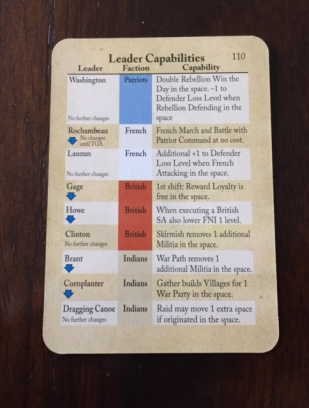 Leaders – I loved the inclusion of Leaders into the design. Each of the Leaders is based on their historical abilities and offer various benefits and interesting game play aspects to each player. A Leader change is forced upon players at the Winter Quarters phase. Who has to change is determined by the first faction listed on the next Event Card. This can be a little frustrating as you may have made plans to benefit from the ability of your Leader in future rounds but now all of a sudden you have to change. I have found that for the Patriots, Washington is amazing as he allows you to double Rebellion Win the Day in the space. For the British, Gage and Howe are very good as they allow you to truly affect things with their abilities. Having trouble with those pesky French blockades? Simply execute a British Special Activity with Howe in command and you can lower the FNI 1 level removing one of them!
Leaders – I loved the inclusion of Leaders into the design. Each of the Leaders is based on their historical abilities and offer various benefits and interesting game play aspects to each player. A Leader change is forced upon players at the Winter Quarters phase. Who has to change is determined by the first faction listed on the next Event Card. This can be a little frustrating as you may have made plans to benefit from the ability of your Leader in future rounds but now all of a sudden you have to change. I have found that for the Patriots, Washington is amazing as he allows you to double Rebellion Win the Day in the space. For the British, Gage and Howe are very good as they allow you to truly affect things with their abilities. Having trouble with those pesky French blockades? Simply execute a British Special Activity with Howe in command and you can lower the FNI 1 level removing one of them!
What I Didn’t Like About Liberty or Death
There really wasn’t very much that I didn’t like about the game and its design. Most of these concerns listed here will have been addressed as a part of the 2nd printing that was just completed by GMT Games.
Rulebook – While the rulebook is well organized and generally very well written, there are a few points that I still have to read 2 or 3 times to make sure I get their intent, even after many plays. I did read a post on BGG where an unsatisfied person called the rulebook an “unmitigated disaster”. I think that is not an accurate statement and feel that the rulebook simply needs some extra attention to be improved. The rules are very simple but their intent is sometimes the part that alludes my understanding.
Administrative Counter Fatigue – This is a concern with all of the COIN Series games and not just Liberty or Death. My concern here is that there are certain aspects, mainly with Control and Opposition/Support, that change so constantly that it can become a little tiresome to have to go back and count and recount each few turns. Some would say that you can simply not worry about that in the early game until the Winter Quarters phase where a Victory Check is made, but I disagree. I have to know each turn where I stand. With my victory conditions being directly tied to either Support or Opposition as well as the current loss total and numbers of forts/villages, I must know where I stand in order to play the game well. Sure, you could just go about your business doing what you feel or know is best, but how do you know that is what you need to do if you are not sure where you stand? I just feel that there is a lot of focus given to this part of the game and it can get a little repetitive and dreary.
Leaders Too Powerful – I kind of alluded to this concern above in my discussions about Leaders,but man some of those Leaders can be game changing! I can tell you that as the Patriots, I dread when Cornplanter and Howe are the Leaders for my enemies. They are just very powerful and during the middle game can really help the British/Indians make significant progress toward winning, leaving only a few rounds to undo what they have done. I also have major concerns about Washington when I am playing the British. That double the Win the Day ability is pretty wicked and can really turn the tide in the continual struggle for the hearts and minds of the people, which is the crux of the game! Plus, he never goes away. At least, Howe and Cornplanter can be replaced but not Washington. Maybe there needs to be an Event added that replicates the infamous Conway Cabal and replaces Washington with Horatio Gates, the Hero of Saratoga (although many believe that Saratoga’s victory belonged more to Benedict Arnold).
Summary/Conclusion
The beauty of all of the COIN Series games is their asymmetry and the treatment of each faction as a separate and distinct entity that has a different set of victory conditions, which makes it very interesting as you not only have to know and focus on your own conditions, but must be aware how your enemies are going to win as well so that you can prevent that from happening. Each faction plays totally differently and the game is not necessarily about battles, but is more about meeting those conditions through any means necessary, which may include area control, killing your enemy’s soldiers, winning over the hearts and minds of the people, etc. The production value of this game is off the charts as the map is absolutely beautiful and probably deserves to be framed and hung in a place of honor on my wall. I love the COIN Series and what Harold Buchanan has done with this design is nothing short of revolutionary. Also, you can check out my Top 10 Games Released in 2016 List and see that Liberty or Death came in at #3 in case you were confused about where I stood on the game.
-Grant



I love euros, I love wargames, but I’m finding it very hard to get into the COIN series and to actually enjoy the decisions and strategy involved. I can’t put my finger on it, as everything on paper appeals. Interestingly, I had a similar experience with Dominant Species which shares some traits.
It’s hard to describe but I felt dissatisfied with a lack of finesse or forward planning over strategic aspects of the game. I suppose that’s the very nature of COIN and what it stands for, but the constant push and pull (referred here in regards to counter fatigue) left me a little numb to the narrative and detached.
This isn’t in any way a criticism of the COIN series, it’s just a ramble from someone who thought they’d LOVE it.
Hopefully the success of COIN will mean the euro/wargame hybrid will continue in other ways and inspire some different kinds of games from publishers too.
LikeLike
Gotta agree completely. LoD also my first COIN game. Long time grognard with more recent ventures into family Eurogames. This combination works so well. Mechanically simple (yet complex in what can be done) and thematically dramatic. Can’t sing the praises enough. LOD has reignited a passion in board gaming that was dying a bit for me.
LikeLiked by 1 person
That is cool. I love the game for many reasons, as you read, but love how much there is to it. After playing I often think about what I could have done differently and that makes me want to play again.
LikeLike
Got mine same time I read Alan Taylor’s American Revolutions. Book is a finalist for Book of the Year from GW Library. While playing game found myself flipping thru book and matching events to text. Awesome learning experience. Used board to discuss Amer Rev with middle school boy. So much more here than just a game!
LikeLiked by 1 person
Regarding Administrative Counter Fatigue, I find that VASSAL solves this quite neatly since all modules have automated control of the spaces and counting score on the tracks. And since I can’t really set up a game long term on my table for solo gaming keeping them in VASSAL is great.
Sure the downside is the lack of tactile manipulation and perhaps appreciating the whole board in one view but I think VASSAL has allowed me to actually set up and play these things 30 minutes to an hour at a time since I can easily pick up where I left off.
Now I just need VASSAL to automate the bots…
LikeLike
I’m a little “meh” on the COIN games – I like Fire in the Lake and Falling Sky, many of the rest I can take or leave, and I prefer Pax Pamir – but Liberty or Death really struck me as among the very worst in the system. It’s mechanically OK, but it’s a perverse and completely whitewashed take on the revolutionary war whose history is either a) wrong or b) 25+ years out of date. The Colonists, for example, win the war by killing Native Americans, Not by running the British out of the country; that’s how the French win. If the British have been expelled but the Colonists have not burned sufficient Native American villages to the ground, the Colonists will lose. The other way for the Colonists to keep the French from winning is to get more of their own troops killed (???). The other deeply offensive thing that Liberty or Death has done is to completely erase slavery from the history the war. Slavery and the role of slaves and freed slaves is literally never mentioned. If a game is pretending to do something serious, this is a grievous mistake. As Americans, we’re way, way past the point we should be pretending that slavery didn’t happen.
LikeLike
I always appreciate opinions about my posts or about the games that I am reviewing but I am confused by your comments. First off, the reference to the World Turned Upside Down in your comment below, is a reference to the song played by the British as they surrendered to Washington at Yorktown and not a quote by Hamilton or from the musical. I don’t know where you got that from, maybe you didn’t read my review. It is an ironic reference by the British in their choice of the song they played at surrender on how things were changing. By the way some would argue that the Revolution paved the way for our government to exist and for the long and cumbersome process of changing things. Secondly, I have played many war games that cover World War II, the Civil War and other conflicts but never once have those games included in their designs any reference to the holocaust or other genocidal practices perpetrated by the Nazis or the issue of slavery during the Civil War. That is not the purpose of the games as they are typically military simulations. Also I believe that the Native American issue was handled with great care and was not intended to be a proclamation on their side versus everyone else but was intended to show that they had concern with the conflict and could either benefit or be negatively affected by the Colonies gaining their freedom from England. I think it is decidedly progressive to allow the Native Americans a seat at the table to attempt to provide them a voice in the conflict. Don’t know if that has ever been done in the past.
LikeLike
I find it ironic that you claim the game is “whitewashed” whilst also complaining that it accurately portrays Patriot actions against the Native American population, which are ignored by every other game about the Revolutionary War which I am aware of.
(Slavery is portrayed in some of the event cards so is definitely present, even though I agree with you that it could be more of an element in the game.)
I find a complaint about the Patriot faction victory condition is a common one from American players who want to win the game by massacaring the British and driving them out of the country. The designer has the perspective that much more important for the Patriot cause was turning hearts and minds in the colonies against British rule, so this is your main objective as the Patriot player. It’s an interesting model and does accurately explain some elements of history (such as Washington’s reputation as Master of Retreat, and some of the actions taken against native American populations even during the Revolutionary War) even if it isn’t completely accurate (and even then, which wargame’s model is?).
LikeLike
I agree, the whole “Colonists need to get their own troops killed to stop the French from winning” deal is pretty ludicrous.
And this game doesn’t really convey the Fabian strategies or cat and mouse of the campaign either.
It’s a square peg round hole for the COIN system. It works pretty well as a 2 player game though.
LikeLike
It is a little ironic that you would use a Hamilton reference in your headline to praise a game that completely writes African-Americans out of the history of the war.
LikeLike
I watched Ricky Royal’s playthrough and the Harsh Rules tutorial series. I understand the sequence of play, components, and card anatomy, but as for the gameplay commands and actions, totally lost. I have never bought a GMT game before, but it’s well known that they have the most difficult wargames EVER to learn that’s on the market today, and LoD is no exception. This is a slogfest…a chore, rather than fun. You have to admit that. For this reason, I just cannot and will not ever buy a GMT game, even with their current 50% off storewide sale that’s going on now until Oct. 15th. You want a great Revolutionary War game? Go with Don’t Tread On Me! by White Dog Games. That one is MUCH easier to learn.
LikeLike
Hi Paul. After reading your comment, I feel you might be talking about another game. I don’t feel as you do and definitely don’t think GMT has the toughest games to learn in the wargaming world (that distinction goes to MMP or Decision Games for sure). But to each his own and I am sorry that you feel this way about LoD.
LikeLike